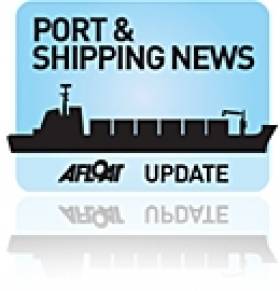Displaying items by tag: Vehiclecarrier cargoship
#GrandeShip - Almost 57,000 tonnes, the impressive Grande Atlantico (as pictured), a vehicle-carrier fresh from dry-docking in the UK, remains anchored in Dublin Bay offshore of the popular Forty Foot bathing place, writes Jehan Ashmore.
Since her arrival last weekend, the multipurpose ro-ro vessel capable of handling 3,515 cars and more than 1,300 containers had been in drydock for a period of one month having undergone maintenance at A&P Falmouth, Cornwall.
Grande Atlantrico measures 214m length X 32m beam X 9.6m draught. She is a 'Grande Class 1' series vessel operated by Italian shipping giant, Grimaldi Lines. The Naples based group, has one of the world's largest fleet of ro-ro, combination ro-ro's carriers in addition to operating ferries in the Mediterranean.
Having anchored less than 2 nautical miles offshore of Sandycove, the appearance of the 1999 built vessel is an unusual sight in Dublin Bay, as normally she and her fleetmates are scheduled to make arrival and departures into Dublin Port during night-time operations.
She is to berth in the port this evening at Alexandra Basin west from where her large stern door will be lowered onto the quayside so to discharge and take on board cargo.
The Gibraltar registered Grande Atlantico operates the 'Grimaldi Central Express Service' which involves calling to Hamburg, Germany and Antwerp Belgium and ports in the following West African countries, Benin, Togo, Nigeria and Ghana.
Following her Dublin departure around midnight, Grande Atlantico is scheduled to reach her final port of call, Tema in Ghana in mid-September.
Grimaldi Lines only began operations to Dublin in 2012, though the shipping company's distinctive yellow hulled ships have been serving Cork Harbour for many years using Ringaskiddy's deepwater berth.






























































